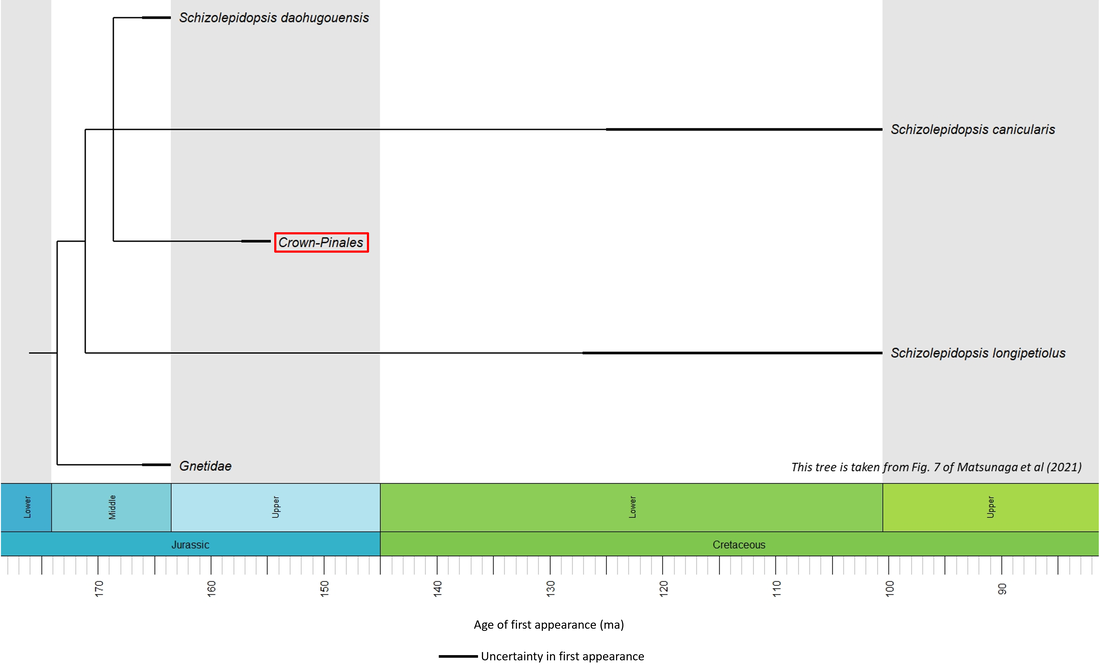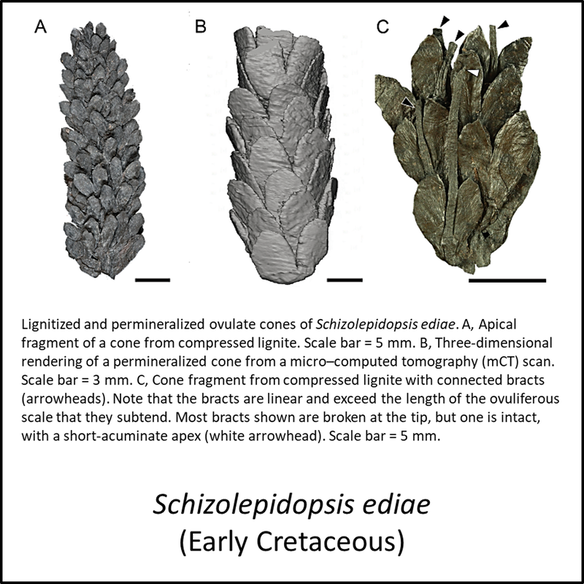The pine family, Pinaceae (Order Pinales, Class Pinopsida) comprise the firs, hemlocks, spruces, larches, cedars and pines. They consist of 11 genera and about 220 species of trees native to northern temperate regions (Encyclopaedia Britannica). The Pinaceae is the only family in Pinales.
Several phylogenetic analyses of the Pinaceae have been published in recent years (Ryberg et al, 2012; Klymiuk and Stockey, 2012; Gernandt et al, 2016; Smith et al, 2017; Gernandt et al, 2018; Matsunaga et al, 2021; Herrera et al, 2021; Andruchow-Colombo et al, 2023), but there are a lot of differences between them. There is particular disagreement over which, if any, of the genera Obirastrobus, Pityostrobus and Pseudoaraucaria belong to the stem group rather than the crown-Pinaceae. The only fossils that have so far never been assigned to the crown group are the three species of Schizolepidopsis shown in the time tree below, based on the work of Matsunaga et al (2021):
Several phylogenetic analyses of the Pinaceae have been published in recent years (Ryberg et al, 2012; Klymiuk and Stockey, 2012; Gernandt et al, 2016; Smith et al, 2017; Gernandt et al, 2018; Matsunaga et al, 2021; Herrera et al, 2021; Andruchow-Colombo et al, 2023), but there are a lot of differences between them. There is particular disagreement over which, if any, of the genera Obirastrobus, Pityostrobus and Pseudoaraucaria belong to the stem group rather than the crown-Pinaceae. The only fossils that have so far never been assigned to the crown group are the three species of Schizolepidopsis shown in the time tree below, based on the work of Matsunaga et al (2021):
Figure 1. Summarized phylogenetic tree of the stem-Pinales
The oldest known member of the stem-Pinaceae is Schizolepidopsis daohugouensis, described from the Middle Jurassic (Callovian) Daohugou Formation in Ningcheng County, Inner Mongolia Autonomous Region, China (Zhang et al, 2011; Matsunaga et al, 2021; Andruchow-Colombo et al, 2023). No public-domain images of this fossil are available, but another member of the genus is shown below. However, note that while Andruchow-Colombo et al (2023) interpret Schizolepidopsis ediae as belonging to the stem-Pinaceae, Matsunaga et al (2021) assign it to the crown group.
Figure 2. Image of a possible member of stem-group Pinacea
Unfortunately, no public-domain images are available for other members of the stem-Pinaceae, so no comments can be made here about evolutionary changes through the stem-to-crown transition.
The oldest known member of the Pinaceae crown group is Eathiestrobus mackenziei (disregarding Herrera et al’s (2021) assignment of this fossil to the stem group), described from the Late Jurassic (Early Kimmeridgian) Kimmeridge Clay Formation in coastal exposures at Eathie on the Black Isle, Norheast Scotland (Rothwell et al, 2012; Andruchow-Colombo et al, 2023). Again, no image is available in the public domain.
As indicated in Figure 1, the conifer stem-to-crown transition took place over a period of no more than 11 million years, from Middle to Late Jurassic time.
The oldest known member of the Pinaceae crown group is Eathiestrobus mackenziei (disregarding Herrera et al’s (2021) assignment of this fossil to the stem group), described from the Late Jurassic (Early Kimmeridgian) Kimmeridge Clay Formation in coastal exposures at Eathie on the Black Isle, Norheast Scotland (Rothwell et al, 2012; Andruchow-Colombo et al, 2023). Again, no image is available in the public domain.
As indicated in Figure 1, the conifer stem-to-crown transition took place over a period of no more than 11 million years, from Middle to Late Jurassic time.
References
Andruchow-Colombo, A., Escapa, I. H., Aagesen, L., & Matsunaga, K. K. (2023). In search of lost time: tracing the fossil diversity of Podocarpaceae through the ages. Botanical Journal of the Linnean Society, boad027.
Gernandt, D. S., Magallón, S., Geada López, G., Zerón Flores, O., Willyard, A., & Liston, A. (2008). Use of simultaneous analyses to guide fossil-based calibrations of Pinaceae phylogeny. International Journal of Plant Sciences, 169(8), 1086-1099.
Gernandt, D. S., Holman, G., Campbell, C., Parks, M., Mathews, S., Raubeson, L. A., ... & Rothwell, G. W. (2016). Phylogenetics of extant and fossil Pinaceae: methods for increasing topological stability. Botany, 94(9), 863-884.
Gernandt, D. S., Reséndiz Arias, C., Terrazas, T., Aguirre Dugua, X., & Willyard, A. (2018). Incorporating fossils into the Pinaceae tree of life. American Journal of Botany, 105(8), 1329-1344.
Herrera, F., Shi, G., Bickner, M. A., Ichinnorov, N., Leslie, A. B., Crane, P. R., & Herendeen, P. S. (2021). Early Cretaceous abietoid Pinaceae from Mongolia and the history of seed scale shedding. American Journal of Botany, 108(8), 1483-1499.
Klymiuk, A. A., & Stockey, R. A. (2012). A Lower Cretaceous (Valanginian) seed cone provides the earliest fossil record for Picea (Pinaceae). American Journal of Botany, 99(6), 1069-1082.
Matsunaga, K. K., Herendeen, P. S., Herrera, F., Ichinnorov, N., Crane, P. R., & Shi, G. (2021). Ovulate cones of Schizolepidopsis ediae sp. nov. provide insights into the evolution of Pinaceae. International Journal of Plant Sciences, 182(6), 490-507.
Rothwell, G. W., Mapes, G., Stockey, R. A., & Hilton, J. (2012). The seed cone Eathiestrobus gen. nov.: fossil evidence for a Jurassic origin of Pinaceae. American Journal of Botany, 99(4), 708-720.
Ryberg, P. E., Rothwell, G. W., Stockey, R. A., Hilton, J., Mapes, G., & Riding, J. B. (2012). Reconsidering relationships among stem and crown group Pinaceae: oldest record of the genus Pinus from the Early Cretaceous of Yorkshire, United Kingdom. International Journal of Plant Sciences, 173(8), 917-932.
Smith, S. Y., Stockey, R. A., Rothwell, G. W., & Little, S. A. (2017). A new species of Pityostrobus (Pinaceae) from the Cretaceous of California: moving towards understanding the Cretaceous radiation of Pinaceae. Journal of Systematic Palaeontology, 15(1), 69-81.
Zhang, J., D'Rozario, A., Yao, J., Wu, Z., & Wang, L. (2011). A new species of the extinct genus Schizolepis from the Jurassic Daohugou Flora, Inner Mongolia, China with special reference to the fossil diversity and evolutionary implications. Acta Geologica Sinica‐English Edition, 85(2), 471-481.
Gernandt, D. S., Magallón, S., Geada López, G., Zerón Flores, O., Willyard, A., & Liston, A. (2008). Use of simultaneous analyses to guide fossil-based calibrations of Pinaceae phylogeny. International Journal of Plant Sciences, 169(8), 1086-1099.
Gernandt, D. S., Holman, G., Campbell, C., Parks, M., Mathews, S., Raubeson, L. A., ... & Rothwell, G. W. (2016). Phylogenetics of extant and fossil Pinaceae: methods for increasing topological stability. Botany, 94(9), 863-884.
Gernandt, D. S., Reséndiz Arias, C., Terrazas, T., Aguirre Dugua, X., & Willyard, A. (2018). Incorporating fossils into the Pinaceae tree of life. American Journal of Botany, 105(8), 1329-1344.
Herrera, F., Shi, G., Bickner, M. A., Ichinnorov, N., Leslie, A. B., Crane, P. R., & Herendeen, P. S. (2021). Early Cretaceous abietoid Pinaceae from Mongolia and the history of seed scale shedding. American Journal of Botany, 108(8), 1483-1499.
Klymiuk, A. A., & Stockey, R. A. (2012). A Lower Cretaceous (Valanginian) seed cone provides the earliest fossil record for Picea (Pinaceae). American Journal of Botany, 99(6), 1069-1082.
Matsunaga, K. K., Herendeen, P. S., Herrera, F., Ichinnorov, N., Crane, P. R., & Shi, G. (2021). Ovulate cones of Schizolepidopsis ediae sp. nov. provide insights into the evolution of Pinaceae. International Journal of Plant Sciences, 182(6), 490-507.
Rothwell, G. W., Mapes, G., Stockey, R. A., & Hilton, J. (2012). The seed cone Eathiestrobus gen. nov.: fossil evidence for a Jurassic origin of Pinaceae. American Journal of Botany, 99(4), 708-720.
Ryberg, P. E., Rothwell, G. W., Stockey, R. A., Hilton, J., Mapes, G., & Riding, J. B. (2012). Reconsidering relationships among stem and crown group Pinaceae: oldest record of the genus Pinus from the Early Cretaceous of Yorkshire, United Kingdom. International Journal of Plant Sciences, 173(8), 917-932.
Smith, S. Y., Stockey, R. A., Rothwell, G. W., & Little, S. A. (2017). A new species of Pityostrobus (Pinaceae) from the Cretaceous of California: moving towards understanding the Cretaceous radiation of Pinaceae. Journal of Systematic Palaeontology, 15(1), 69-81.
Zhang, J., D'Rozario, A., Yao, J., Wu, Z., & Wang, L. (2011). A new species of the extinct genus Schizolepis from the Jurassic Daohugou Flora, Inner Mongolia, China with special reference to the fossil diversity and evolutionary implications. Acta Geologica Sinica‐English Edition, 85(2), 471-481.
Image credits – stem-Pinales
- Header (Western hemlock - Tsuga heterophylla): Ebustad, Public domain, via Wikimedia Commons
- Figure 2: From Open Access article Matsunaga, K. K., Herendeen, P. S., Herrera, F., Ichinnorov, N., Crane, P. R., & Shi, G. (2021). Ovulate cones of Schizolepidopsis ediae sp. nov. provide insights into the evolution of Pinaceae. International Journal of Plant Sciences, 182(6), 490-507.

